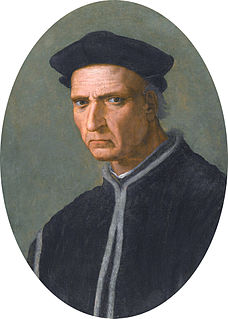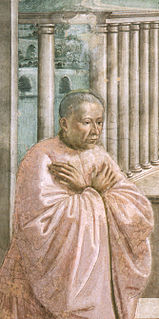Related Research Articles

Lorenzo di Piero de' Medici was an Italian statesman, banker, de facto ruler of the Florentine Republic and the most powerful and enthusiastic patron of Renaissance culture in Italy. Also known as Lorenzo the Magnificent by contemporary Florentines, he was a magnate, diplomat, politician and patron of scholars, artists, and poets. As a patron, he is best known for his sponsorship of artists such as Botticelli and Michelangelo. He held the balance of power within the Italic League, an alliance of states that stabilized political conditions on the Italian peninsula for decades, and his life coincided with the mature phase of the Italian Renaissance and the Golden Age of Florence. On the foreign policy front, Lorenzo manifested a clear plan to stem the territorial ambitions of Pope Sixtus IV, in the name of the balance of the Italian League of 1454. For these reasons, Lorenzo was the subject of the Pazzi conspiracy (1478), in which his brother Giuliano was assassinated. The Peace of Lodi of 1454 that he supported among the various Italian states collapsed with his death. He is buried in the Medici Chapel in Florence.

Girolamo Savonarola, OP or Jerome Savonarola was an Italian Dominican friar from Ferrara and preacher active in Renaissance Florence. He was known for his prophecies of civic glory, the destruction of secular art and culture, and his calls for Christian renewal. He denounced clerical corruption, despotic rule, and the exploitation of the poor.

The Republic of Florence, officially the Florentine Republic, was a medieval and early modern state that was centered on the Italian city of Florence in Tuscany. The republic originated in 1115, when the Florentine people rebelled against the Margraviate of Tuscany upon the death of Matilda of Tuscany, who controlled vast territories that included Florence. The Florentines formed a commune in her successors' place. The republic was ruled by a council known as the Signoria of Florence. The signoria was chosen by the gonfaloniere, who was elected every two months by Florentine guild members.

Alessandro de' Medici, nicknamed "il Moro" due to his dark complexion, Duke of Penne and the first Duke of the Florentine Republic, was ruler of Florence from 1530 to his death in 1537. The first Medici to rule Florence as a hereditary monarch, Alessandro was also the last Medici from the senior line of the family to lead the city. His assassination at the hands of distant cousin Lorenzaccio caused the title of Duke to pass to Cosimo I de Medici, from the family's junior branch.

Francesco Guicciardini was an Italian historian and statesman. A friend and critic of Niccolò Machiavelli, he is considered one of the major political writers of the Italian Renaissance. In his masterpiece, The History of Italy, Guicciardini paved the way for a new style in historiography with his use of government sources to support arguments and the realistic analysis of the people and events of his time.

Piero di Tommaso Soderini also known as Pier Soderini, was an Italian statesman of the Republic of Florence.

Filippo Buonarroti, the great-grandnephew of Michelangelo Buonarroti, was a Florentine official at the court of Cosimo III, Grand Duke of Tuscany and an antiquarian, whose Etruscan studies, among the earliest in that field, inspired Antonio Francesco Gori. The Etruscan art and antiquities in the family palazzo-museum of Florence, Casa Buonarroti, are his contribution to the artistic-intellectual memorial to the Buonarroti.
While Florence itself needs no introduction as the birthplace of the Italian Renaissance, the music of Florence may, in fact, need such an introduction. The city was at the heart of much of the entire Western musical tradition. It was here that the Florentine Camerata convened in the mid-16th century and experimented with setting tales of Greek mythology to music and staging the result—in other words, the first operas, setting the wheels in motion not just for the further development of the operatic form, but for later developments of separate "classical" forms such as the symphony.

Giovanni Tornabuoni was an Italian merchant, banker and patron of the arts from Florence.
The Accademia Platonica di Firenze or Platonic Academy of Florence was an informal discussion group which formed around Marsilio Ficino in the Florentine Renaissance of the fifteenth century.

The palleschi, also known as bigi, were partisans of the Medici family in Florence. The name derived by the Medici coat-of-arms, bearing six 'balls' (palle).

Benedetto Pamphili was an Italian cardinal, patron of the arts and librettist for many composers.

Innocenzo Cibo was an Italian cardinal and archbishop.

This timeline lists important events relevant to the life of the Italian diplomat, writer and political philosopher Niccolò di Bernardo dei Machiavelli (1469–1527).
Paolo Antonio Soderini was a noble Florentine jurist active in the anti-Medicean Florentine republic, who spent some years resident at Rome.

Frank (Anthony) D'Accone was an American musicologist. D'Accone is the author of documentary studies of the musicians and institutions that produced the music of the Florentine and Siennese Renaissance. His many modern editions of the music of this culture made available to present-day performers and scholars for the first time in several centuries a wide-ranging picture of the musical life in Tuscany during the Renaissance. Musicologist Lewis Lockwood stated that his body of work "substantially extends current knowledge of the music history of the Italian Renaissance."

Giovanni di Bernardo Rucellai was an Italian humanist, poet, dramatist and man of letters in Renaissance Florence, in Tuscany, Italy. A member of a wealthy family of wool merchants and one of the richest men in Florence, he was cousin to Pope Leo X and linked by marriage to the powerful Strozzi and de' Medici families. He was born in Florence, and died in Rome. He was the son of Bernardo Rucellai (1448–1514) and grandson of Giovanni di Paolo Rucellai (1403–1481). He is now remembered mostly for his poem Le Api, one of the first poems composed in versi sciolti to achieve widespread acclaim.
The following is a timeline of the history of the city of Florence, Tuscany, Italy.

Alessandro Felici was an Italian composer and violinist, not to be confused with his contemporary, Roman composer Felice Alessandri.

Giuseppe Bencivenni Pelli or Giuseppe Pelli Bencivenni was an Italian civil servant and essayist. Born and dying in Florence, he served as director of the Uffizi Gallery from 1775 to 1793. He was the last member of a Florentine patrician family.
References
- ↑ (in Italian) Archivio di Stato di Firenze, lettera di Alessandro Braccesi a Piero de' Medici, 23 gennaio 1493.
- ↑ Documents worked on by him as a notary are now in Florence's Archivio di Stato, Notarile B 2317-2325.
- ↑ Biblioteca vaticana, codice Vat. lat. 10681, ff. 1-115.
- ↑ (in Italian) Archivio di Stato di Firenze, Dieci, Deliberationes, 21, f. 140v.
- ↑ (in Italian) Archivio di Stato di Firenze, Dieci, Deliberationes, f. 172v.
- ↑ (in Italian) Archivio di Stato di Firenze, Otto, Deliberationes, 1, ff. 3, 10, 15